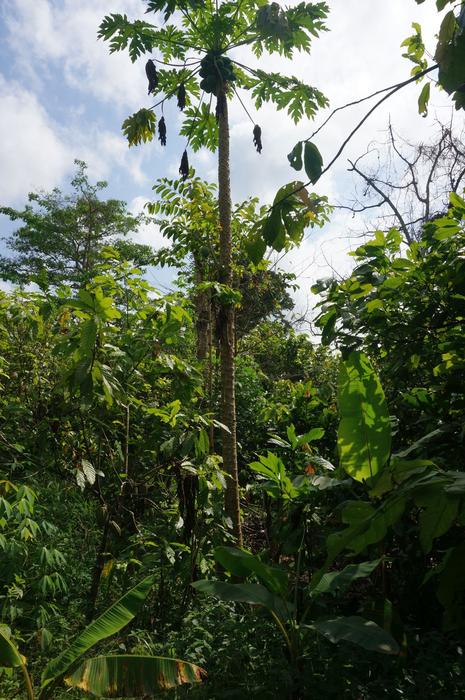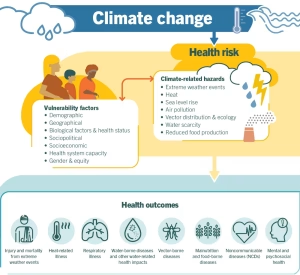From Forecast To Fact: What 1990s Climate Models Got Exactly Right – Forbes

Report on Climate Change Projections and Sustainable Development Goal Implications
Executive Summary
This report analyzes the verification of long-standing climate change projections concerning atmospheric greenhouse gases, global temperatures, and extreme weather phenomena. Data from leading scientific bodies, including the World Meteorological Organization (WMO) and the Intergovernmental Panel on Climate Change (IPCC), confirms the accuracy of forecasts made in the late 20th century. These findings underscore the escalating climate crisis, which poses a direct and immediate threat to the achievement of multiple Sustainable Development Goals (SDGs), most notably SDG 13 (Climate Action), SDG 11 (Sustainable Cities and Communities), and SDG 9 (Industry, Innovation, and Infrastructure).
Atmospheric Greenhouse Gas Concentrations: A Challenge to SDG 13
The continuous rise in atmospheric carbon dioxide (CO₂) levels represents a critical failure in global efforts to achieve SDG 13 (Climate Action). The data confirms that the planet is moving further from, not closer to, key climate targets.
Key Findings:
- The World Meteorological Organization’s 2025 Greenhouse Gas report indicated that global CO₂ levels increased by 3.5 ppm between 2023 and 2024, the largest annual rise recorded since 1957.
- Early climate models from the 1980s accurately projected that atmospheric CO₂ would surpass 400 ppm in the early 21st century.
- By 2023, measured CO₂ levels exceeded 420 ppm, aligning with these foundational scientific forecasts.
This unabated increase in greenhouse gases is the primary driver of climate change, directly undermining progress on SDG 13 and creating cascading negative impacts on other development goals.
Global Temperature Rise and Climate Action Targets
The observed increase in global mean temperatures validates early IPCC projections and highlights the world’s trajectory away from the Paris Agreement’s goal of limiting warming, a central component of SDG 13.
Observed Temperature Anomalies:
- Early IPCC reports projected a global temperature rise of approximately 0.2 to 0.3 °C per decade if emissions continued unabated.
- The WMO confirmed 2024 as the warmest year on record, with global temperatures approximately 1.55°C above pre-industrial levels.
- Observed consequences include longer and more intense heat waves, milder winters, and record-shattering ocean temperatures, all of which threaten ecosystems and human well-being, impacting SDG 14 (Life Below Water) and SDG 15 (Life on Land).
Climate Impacts on Sustainable Cities and Communities (SDG 11)
Verified climate trends, including intensified rainfall and rising sea levels, are placing unprecedented stress on urban environments, directly challenging the resilience and sustainability targets of SDG 11.
Increased Extreme Precipitation Events
A warmer atmosphere holds more moisture, leading to more intense rainfall events that overwhelm existing infrastructure, jeopardizing progress on SDG 9 and SDG 11.
- Scientific warnings from 1989 correctly predicted that rising temperatures would lead to heavier and more frequent extreme rainfall.
- Data from North America and Europe shows a significant increase in the frequency and intensity of extreme single-day precipitation events since the 1980s.
- This trend strains municipal drainage systems, disrupts logistics, and increases flood risk, requiring urgent adaptation of infrastructure to ensure community safety.
Accelerated Sea Level Rise
The rise in global mean sea level aligns with early scientific models, posing an existential threat to coastal communities and economies, which are central to SDG 11 and SDG 14.
- Projections from the 1990s forecast a sea level rise of approximately 8 centimeters by 2020.
- Modern satellite and tide-gauge data confirm a rise of about 9 centimeters over the same period.
- This trend, driven by thermal expansion and accelerating ice-sheet melt, directly impacts coastal real estate, port operations, and critical infrastructure, necessitating a recalibration of risk management frameworks to protect vulnerable populations.
Intensification of Extreme Storms: A Risk to Infrastructure and Industry (SDG 9)
While the total number of tropical cyclones has not necessarily increased, their intensity has, confirming early scientific hypotheses. This shift poses a significant threat to the resilience of infrastructure, industry, and supply chains, which are foundational to SDG 9.
Key Observations on Storm Intensity:
- An increased proportion of tropical cyclones are reaching high-intensity Categories 4 and 5.
- Rapid intensification events, where storms strengthen dramatically in a short period, are becoming more frequent. Hurricane Milton (2024) and Hurricane Melissa (2025) serve as recent examples of this phenomenon.
- This trend reduces the operational window for emergency response and requires industries—from energy to logistics—to build greater resilience into their planning and assets to support sustainable industrialization as outlined in SDG 9.
Conclusion: From Prediction to SDG-Aligned Preparation
The validation of decades-old climate projections provides an unequivocal basis for action. The observed trends in atmospheric composition, global temperatures, and extreme weather are not abstract scientific data points; they are measurable indicators of the growing threat to the global achievement of the Sustainable Development Goals. Business and policy leaders must integrate these verified climate trends into strategic planning to build resilience, mitigate risks, and accelerate the transition required to meet the urgent mandate of SDG 13 and its interconnected goals.
Analysis of Sustainable Development Goals in the Article
1. Which SDGs are addressed or connected to the issues highlighted in the article?
-
SDG 13: Climate Action
- The entire article is fundamentally about climate action. It details the causes and consequences of climate change, directly aligning with the goal to “take urgent action to combat climate change and its impacts.” The text focuses on the measurable evidence of climate change, such as rising CO₂ levels, increasing global temperatures, and the intensification of extreme weather events, which are central concerns of SDG 13.
-
SDG 11: Sustainable Cities and Communities
- The article connects climate change impacts to urban and community resilience. It mentions that “Municipalities are straining to modernize drainage systems” due to heavier rainfall and that “Real estate values in coastal zones are adjusting” because of sea-level rise. This directly relates to SDG 11’s aim to make cities and human settlements inclusive, safe, resilient, and sustainable, particularly in the face of climate-related disasters.
-
SDG 14: Life Below Water
- The article addresses the impact of climate change on oceans, a key component of SDG 14. It highlights that “ocean temperatures are shattering records” and that sea-level rise is driven by “thermal expansion in warming oceans” and “melting ice sheets.” These points are directly relevant to conserving and sustainably using the oceans, seas, and marine resources.
-
SDG 9: Industry, Innovation, and Infrastructure
- The article discusses the need for infrastructure to adapt to new climate realities. The mention of drainage systems being overwhelmed, and the need for infrastructure planners to account for tidal flooding, points to the necessity of building resilient infrastructure, which is a core component of SDG 9.
2. What specific targets under those SDGs can be identified based on the article’s content?
-
Under SDG 13: Climate Action
- Target 13.1: “Strengthen resilience and adaptive capacity to climate-related hazards and natural disasters in all countries.” The article directly addresses this by describing the need for adaptation in response to observed climate impacts. For example, it states, “For those of us in weather and risk management, this shift has moved from a scientific discussion to an operational reality,” and that “resilience planning now hinges on anticipation, not reaction.”
- Target 13.2: “Integrate climate change measures into national policies, strategies and planning.” The article’s concluding message is a call for this integration, urging “business and policy leaders” to “treat today’s verified climate trends as tomorrow’s planning inputs” to reshape markets and infrastructure.
-
Under SDG 11: Sustainable Cities and Communities
- Target 11.5: “By 2030, significantly reduce the number of deaths and the number of people affected and substantially decrease the direct economic losses… caused by disasters, including water-related disasters.” The article’s focus on increased flooding, rising sea levels impacting coastal zones, and more powerful hurricanes directly relates to the water-related disasters this target aims to mitigate. The discussion of recalculating insurance exposure and adjusting real estate values points to the economic losses from these events.
- Target 11.b: “By 2020, substantially increase the number of cities and human settlements adopting and implementing integrated policies and plans towards… adaptation to climate change, resilience to disasters…” The article provides concrete examples of this in action, noting that “Municipalities are straining to modernize drainage systems” and “Infrastructure planners are accounting for ‘sunny day’ tidal flooding.”
-
Under SDG 14: Life Below Water
- Target 14.3: “Minimize and address the impacts of ocean acidification, including through enhanced scientific cooperation at all levels.” While not mentioning acidification specifically, the article discusses the root causes (rising atmospheric CO₂) and direct impacts on oceans, such as “ocean temperatures… shattering records” and “thermal expansion.” The entire article, which is based on scientific data from organizations like the WMO and IPCC, exemplifies the scientific cooperation needed to address these issues.
3. Are there any indicators mentioned or implied in the article that can be used to measure progress towards the identified targets?
Yes, the article is rich with specific, measurable indicators used to track the progression of climate change and its impacts.
-
Atmospheric CO₂ Concentration:
- The article explicitly states that “global carbon dioxide levels surged by 3.5 ppm between 2023 and 2024” and have “exceeded 420 ppm.” This is a primary indicator for tracking greenhouse gas levels in the atmosphere.
-
Global Average Temperature Anomaly:
- The text refers to the scientific projection of a rise of “roughly 0.2 to 0.3 °C per decade” and notes that 2024 was the “warmest year on record.” It also mentions that current temperatures are “about 2°C above pre-industrial levels,” a key metric in climate science.
-
Global Mean Sea Level Rise:
- A precise indicator is provided: “Modern satellite altimetry and tide-gauge data show a rise of about 9 centimeters” since the mid-1990s. This directly measures one of the most significant impacts of climate change.
-
Frequency and Intensity of Extreme Weather Events:
- The article implies indicators for disaster risk by noting “a clear rise in the frequency and intensity of extreme single-day precipitation events” and an “increase in the proportion of tropical cyclones reaching Categories 4 and 5.” The rapid intensification of hurricanes, measured in wind speed increase over time (e.g., “jump 95 mph in just 24 hours”), is also cited as a key indicator of increasing storm power.
4. Table of SDGs, Targets, and Indicators
| SDGs | Targets | Indicators |
|---|---|---|
| SDG 13: Climate Action |
13.1: Strengthen resilience and adaptive capacity to climate-related hazards.
13.2: Integrate climate change measures into policies and planning. |
– Atmospheric CO₂ concentration (e.g., “surged by 3.5 ppm,” “exceeded 420 ppm”). – Global average temperature increase (e.g., “warmest year on record,” “2°C above pre-industrial levels”). – Need for business and policy leaders to use climate trends as “planning inputs.” |
| SDG 11: Sustainable Cities and Communities |
11.5: Reduce economic losses and people affected by disasters.
11.b: Increase cities implementing plans for climate change adaptation and resilience. |
– Frequency and intensity of extreme precipitation events. – Proportion of tropical cyclones reaching Categories 4 and 5. – Impact on real estate values in coastal zones. – Need for municipalities to modernize drainage systems. |
| SDG 14: Life Below Water | 14.3: Minimize and address the impacts of ocean acidification. |
– Rise in ocean temperatures (“shattering records”). – Global mean sea-level rise (“a rise of about 9 centimeters”). – Thermal expansion of oceans. |
| SDG 9: Industry, Innovation, and Infrastructure | 9.1: Develop quality, reliable, sustainable and resilient infrastructure. |
– Overwhelmed drainage systems requiring modernization. – Infrastructure planners accounting for “sunny day” tidal flooding. |
Source: forbes.com
What is Your Reaction?
 Like
0
Like
0
 Dislike
0
Dislike
0
 Love
0
Love
0
 Funny
0
Funny
0
 Angry
0
Angry
0
 Sad
0
Sad
0
 Wow
0
Wow
0
















































:focal(1500,1000)/https://media.globalcitizen.org/a6/9a/a69a4720-d8a1-4715-b596-18738d03c05c/rotary_polio_hero_image.jpg?#)







/countries/sri-lanka/photo-credit---dmc-sri-lanka.tmb-1200v.jpg?sfvrsn=dc298bcc_1#)


















